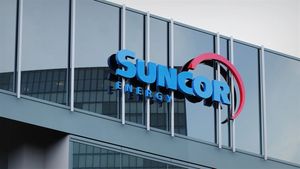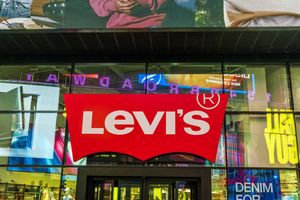
Fashion brand Ralph Lauren (NYSE: RL) announced better-than-expected revenue in Q2 CY2025, with sales up 13.7% year on year to $1.72 billion. Its non-GAAP profit of $3.77 per share was 7.8% above analysts’ consensus estimates.
Is now the time to buy RL? Find out in our full research report (it’s free).
Ralph Lauren (RL) Q2 CY2025 Highlights:
- Revenue: $1.72 billion vs analyst estimates of $1.66 billion (13.7% year-on-year growth, 3.6% beat)
- Adjusted EPS: $3.77 vs analyst estimates of $3.50 (7.8% beat)
- Adjusted EBITDA: $348.4 million vs analyst estimates of $328.4 million (20.3% margin, 6.1% beat)
- Operating Margin: 15.9%, up from 13.8% in the same quarter last year
- Locations: 1,234 at quarter end, down from 1,262 in the same quarter last year
- Constant Currency Revenue rose 11.4% year on year (2.8% in the same quarter last year)
- Same-Store Sales rose 9.2% year on year (3.1% in the same quarter last year)
- Market Capitalization: $17.48 billion
StockStory’s Take
Ralph Lauren's second quarter results saw the company outperform Wall Street's revenue and profit expectations, yet the market responded negatively. Management attributed the quarter’s success to robust international growth—especially in Asia and Europe—along with strong direct-to-consumer sales and new customer acquisition. CEO Patrice Louvet highlighted brand elevation and digital engagement as key drivers, noting, “We delivered double-digit top line growth in both Asia and Europe, and high single-digit growth in North America.” Despite these strengths, ongoing macroeconomic volatility and potential cost pressures weighed on investor sentiment.
Looking forward, Ralph Lauren’s guidance is shaped by continued investment in brand-building, technology, and supply chain agility, as well as caution around the impact of tariffs and consumer price sensitivity. Management pointed to durable drivers such as expanded product categories and market share gains, but CFO Justin Picicci cautioned, “The biggest unknown sitting here today is the price sensitivity and how the consumer reacts to the broader pricing environment.” The company expects further growth in Asia and Europe, while the U.S. outlook remains cautious due to inflationary concerns and tariff-related headwinds.
Key Insights from Management’s Remarks
Management emphasized that broad-based international momentum, direct-to-consumer strength, and product innovation underpinned the quarter’s outperformance, even as caution remains over the potential impact of tariffs and consumer behavior.
- Asia and Europe led momentum: Ralph Lauren achieved double-digit sales growth in Asia—driven by China and Japan—and strong results in Europe, supported by both retail and wholesale channels. Management credited targeted marketing activations, including major fashion events in Shanghai and Milan, for driving customer engagement and brand awareness.
- Direct-to-consumer (DTC) channel strength: The majority of growth came from DTC channels, with digital and brick-and-mortar stores both posting significant comparable sales increases. Digital engagement strategies, such as site enhancements and social media expansion, led to the addition of 1.4 million new customers, skewing younger and more diverse.
- Product innovation and category expansion: Core products—accounting for over 70% of the business—posted mid-teens growth, while high-potential categories like women’s apparel, outerwear, and handbags outpaced the company average. The launch of the Polo Play handbag and new home collections were specifically called out for their strong performance.
- Pricing and margin discipline: Average unit retail (AUR) growth was driven by reduced discounting, higher full-price sales, and selective pricing actions, especially in North America and Asia. The company maintained its elevation strategy, resulting in higher gross and operating margins, despite increased marketing investments.
- Inventory and supply chain management: Inventory levels increased as the company accelerated core product receipts ahead of anticipated tariffs. Management indicated that this was a strategic move and expects inventory growth to normalize in line with revenue as the year progresses.
Drivers of Future Performance
Ralph Lauren’s outlook is underpinned by international expansion, product elevation, and cautious management of tariff and inflation risks.
- Sustained international expansion: Management sees ongoing growth opportunities in Asia and Europe, with China identified as a key white space for further market penetration. Targeted brand activations and new store openings are expected to drive customer recruitment and top-line gains in these regions.
- Tariff and inflation headwinds: The company anticipates that recently announced tariffs and potential inflationary pressures will impact North American profitability and could lead to increased price sensitivity among consumers. Management plans to offset these pressures through selective pricing, supply chain diversification, and cost optimization but remains cautious about the second half of the year.
- Continued investment in brand and technology: Ralph Lauren will maintain investments in marketing, digital platforms, and supply chain automation to enhance customer experience and operational efficiency. The rollout of AI-driven inventory management and next-generation distribution centers is expected to improve sales and inventory turnover, though these initiatives may pressure short-term expenses.
Catalysts in Upcoming Quarters
In the coming quarters, the StockStory team will be monitoring (1) consumer response to price increases and tariffs in North America, (2) the pace of international expansion and new market entries, particularly in China, and (3) the effectiveness of investments in digital platforms and supply chain automation. Continued innovation in product categories and the ability to sustain gross margin gains despite cost pressures will also be critical markers of successful execution.
Ralph Lauren currently trades at $288.60, down from $302.96 just before the earnings. In the wake of this quarter, is it a buy or sell? See for yourself in our full research report (it’s free).
Now Could Be The Perfect Time To Invest In These Stocks
Trump’s April 2025 tariff bombshell triggered a massive market selloff, but stocks have since staged an impressive recovery, leaving those who panic sold on the sidelines.
Take advantage of the rebound by checking out our Top 5 Growth Stocks for this month. This is a curated list of our High Quality stocks that have generated a market-beating return of 183% over the last five years (as of March 31st 2025).
Stocks that made our list in 2020 include now familiar names such as Nvidia (+1,545% between March 2020 and March 2025) as well as under-the-radar businesses like the once-micro-cap company Kadant (+351% five-year return). Find your next big winner with StockStory today.
StockStory is growing and hiring equity analyst and marketing roles. Are you a 0 to 1 builder passionate about the markets and AI? See the open roles here.





